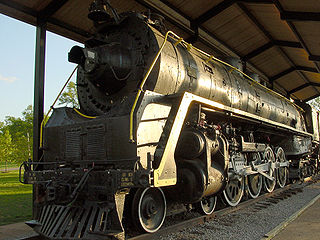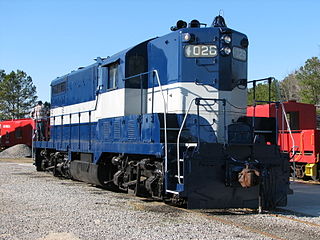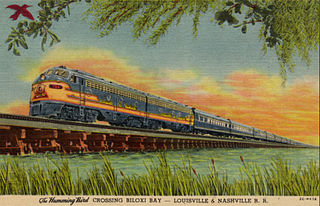
Clarksville is the county seat of Montgomery County, Tennessee, United States. It is the fifth-largest city in the state behind Nashville, Memphis, Knoxville, and Chattanooga. The city had a population of 132,929 at the 2010 census, and an estimated population of 158,146 in 2019.

U.S. Route 79 is a United States highway in the Southern United States. The route is officially considered and labeled as a north-south highway, but it is actually more of a diagonal northeast-southwest highway. The highway's northern/eastern terminus is in Russellville, Kentucky, at an intersection with U.S. Highway 68 and KY 80. Its southern/western terminus is in Round Rock, Texas, at an intersection with Interstate 35, ten miles (16 km) north of Austin. US 79, US 68, and Interstate 24/US 62 are the primary east–west access points for the Land Between the Lakes recreation area straddling the Kentucky/Tennessee border.

The Monon Railroad, also known as the Chicago, Indianapolis, and Louisville Railway from 1897 to 1956, was an American railroad that operated almost entirely within the state of Indiana. The Monon was merged into the Louisville and Nashville Railroad in 1971, and much of the former Monon right of way is owned today by CSX Transportation. In 1970, it operated 540 miles (870 km) of road on 792 miles (1,275 km) of track; that year it reported 1320 million ton-miles of revenue freight and zero passenger-miles.

The Nashville, Chattanooga and St. Louis Railway was a railway company operating in the southern United States in Kentucky, Tennessee, Alabama and Georgia. It began as the Nashville and Chattanooga Railroad, chartered in Nashville in December 11, 1845, built to 5 ft gauge and was the first railway to operate in the state of Tennessee. By the turn of the twentieth century, the NC&StL grew into one of the most important railway systems in the southern United States.

The Louisville and Nashville Railroad, commonly called the L&N, was a Class I railroad that operated freight and passenger services in the southeast United States.

The Pan-American was a passenger train operated by the Louisville and Nashville Railroad (L&N) between Cincinnati, Ohio and New Orleans, Louisiana. It operated from 1921 until 1971. From 1921 to 1965 a section served Memphis, Tennessee via Bowling Green, Kentucky. The Pan-American was the L&N's flagship train until the introduction of the Humming Bird in 1946. Its name honored the substantial traffic the L&N carried to and from the seaports on the Gulf of Mexico. The Pan-American was one of many trains discontinued when Amtrak began operations in 1971.

The Georgia Railroad and Banking Company also seen as "GARR", was a historic railroad and banking company that operated in the U.S. state of Georgia. In 1967 it reported 833 million revenue-ton-miles of freight and 3 million passenger-miles; at the end of the year it operated 331 miles (533 km) of road and 510 miles (820 km) of track.

The Floridian was a train operated by Amtrak from 1971 to 1979 that ran from Chicago and–via two sections south of Jacksonville–Miami and St. Petersburg, Florida. Its route mainly followed that of several former Louisville & Nashville Railroad (L&N) passenger trains, including the Humming Bird. Originating in Chicago, the train served Lafayette and Bloomington, Indiana; Louisville and Bowling Green, Kentucky; Nashville, Tennessee; Decatur, Birmingham, Montgomery and Dothan, Alabama; and Thomasville, Valdosta and Waycross, Georgia.
Memphis Union Station was a passenger terminal in Memphis, Tennessee. It served as a hub between railroads of the Southwest, the Missouri Pacific Railroad and the St. Louis Southwestern Railway, and railroads of the Southeast, the Louisville and Nashville Railroad, the Nashville, Chattanooga and St. Louis Railway and the Southern Railway. The terminal, completed in 1912, was built in the Beaux-Arts style and was located on Calhoun Street, between south Second Street and Rayburn Boulevard. It was demolished in 1969. This location in south Memphis was approximately two blocks east of the other major Memphis railroad terminal, Memphis Grand Central Station.
The L & N Train Station is a restored railroad station in Clarksville, Tennessee. It was opened by the Memphis, Clarksville and Louisville Railroad in 1859.
The Kingsport Subdivision is a 133.2-mile railroad line owned and operated by CSX Transportation in the U.S. states of Kentucky, Virginia, and Tennessee. It was formerly part of the Huntington West Division. It became part of the CSX Florence Division on June 20, 2016. Running from Elkhorn City, Kentucky, south to Erwin, Tennessee, it forms the north half of the former Clinchfield Railroad; the south half, from Erwin to Spartanburg, South Carolina, is now the Blue Ridge Subdivision. From Elkhorn City, the line continues north as the Big Sandy Subdivision to Catlettsburg, Kentucky, on the Ohio River; trains can then continue to Ohio and other Midwest points. From Spartanburg, trains can continue to Georgia, Florida, or other Southeast states.
The Memphis Subdivision is a railroad line owned and operated by CSX Transportation in the U.S. state of Tennessee. The line runs from east of Bruceton west and southwest to Memphis, where it terminates at CSX Leewood Yard, mostly along a former Louisville and Nashville Railroad line from Nashville towards Louisville, Kentucky.

The Humming Bird was a named train of the Louisville and Nashville Railroad (L&N). The train, inaugurated in 1947, originally ran from Cincinnati, Ohio, to New Orleans, Louisiana, via Louisville, Nashville, Birmingham, Montgomery and Mobile and later via a connection at Bowling Green, Kentucky, to Memphis, Tennessee. A connection to Chicago was provided by the Chicago and Eastern Illinois Railroad. It had separate sections in the north and the south. The main northern part originated in Cincinnati; other sections originated in St. Louis and from Chicago. These sections linked with the main part of the train in Nashville. To the south, a connecting train option in Flomaton, Alabama offered train travel to Pensacola, Florida.
The Louisville and Nashville Depot, or Louisville and Nashville Railroad Depot or Louisville and Nashville Passenger Station, Louisville and Nashville Railroad Passenger Depot or variations, may refer to the following former and active train stations previously used by the Louisville and Nashville Railroad. Some of these are listed on the National Register of Historic Places (NRHP).

The Historic Railpark and Train Museum, formerly the Louisville and Nashville Railroad Station in Bowling Green, Kentucky, is located in the historic railroad station. The building was placed on the National Register of Historic Places on December 18, 1979. Opened in 1925, the standing depot is the third Louisville & Nashville Railroad depot that served Bowling Green.

The L & N Railroad Depot in the Hopkinsville Commercial Historic District of Hopkinsville, Kentucky is a historic railroad station on the National Register of Historic Places. It was built by the Louisville & Nashville Railroad in 1892.

The Dixie Flyer was a premier named passenger train that operated from 1892 to 1965 via the "Dixie Route" from Chicago and St. Louis via Evansville, Nashville, and Atlanta to Florida. However, the train persisted to 1969 as an Atlanta to Florida operation, solely run by the Atlantic Coast Line Railroad and its successor. The Flyer's route varied in early years, but by about 1920 was set as follows:
John J. Irvine was a railroad worker, engineer, and politician in Chattanooga, Tennessee. He was clerk of the circuit court of Chattanooga from 1886 to 1890 and he ran for mayor of the town in 1891. In 1899, he was a noted leader of a movement to establish an African-American colony in the Western United States.
The following is a timeline of the history of the city of Clarksville, Tennessee, United States.
Whiteford Russell Cole was an American businessman. He was the president of the Louisville and Nashville Railroad from 1926 to 1934, and a director of many companies. During the railroad strike actions of 1921–1922, he threatened his workers with dismissal and loss of pensions. His mansion in Louisville, Kentucky is the official residence of the president of the University of Louisville.












